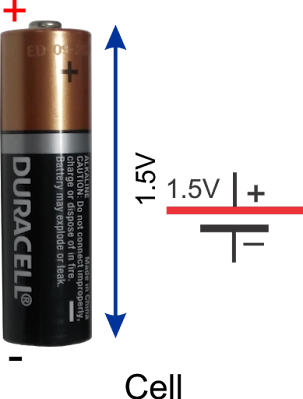Cell

Battery (Cells in Series)
 If four cells of 1.5volt are
connected in series, the total voltage is 4 X 1.5V = 6.0V. Please note that in series connection positive terminal of one to the negative
terminal of other and so on. The voltage of each cell gets added in this type
of connection. If we connect positive terminal together or negative terminal
together, both cell will oppose each other and net voltage will be “ZERO”. In series connection the voltage increases but the current delivery capacity remains same.
If four cells of 1.5volt are
connected in series, the total voltage is 4 X 1.5V = 6.0V. Please note that in series connection positive terminal of one to the negative
terminal of other and so on. The voltage of each cell gets added in this type
of connection. If we connect positive terminal together or negative terminal
together, both cell will oppose each other and net voltage will be “ZERO”. In series connection the voltage increases but the current delivery capacity remains same.Battery (Cells in Parallel)

And if any number of 1.5V cells are connected in parallel, the voltage remains same i.e. 1.5V. Here the net voltage remain same, but the current delivery capacity adds up. In parallel connection also, please note that similar
terminals are connected together. The net voltage is same as voltage of each
cell. In parallel connection we should connect same type of cell in group, if
we connect a 1.5V cell in parallel to 3.7V, then due to potential difference
both cells, current from 3.7V will push to 1.5V cell trying to charge it. This
will continue till voltage of both cells become equal. But in this case 1.5V
cell will overcharge and may burst. Also its important not connect opposite
polarity of two cells in parallel connection, else it will create a short
circuit and may harm you.
mAh or Ah Rating
So, one specification of cell or
battery is its voltage rating and the other is “Ah” or “mAh” rating. This specifies
how long the battery will sustain if specific amount of current is drawn from
it. It is the product of Current (mA or A) and Hours(H) For example if the mAh
rating of any battery is say 2000mAh, means if we connect any load on this
battery which draws 2000mA current, then this battery will sustain for 1Hr. If
we draw lesser current it will lasts longer. So, if we draw 1000mA from same
battery it will last for 2Hrs. So, we can calculate this using formula mAh rating
= Current in mA X time in Hours. So time = mAh / mA. So time for this battery
if we draw 1000mA, we can calculate it as 2000mAh / 1000mA = 2Hrs.
For bigger batteries used in cars
or home inverters, rating is normally in “Ah”, so a 140Ah battery will last for
1hrs is we draw 140Amps. Similarly if we draw 1Amp, time = 140Ah / 1A = 140Hrs.
Other rating is the maximum
current what we can draw from battery; some batteries provide high current (in
Amperes) like Li-Po (Lithium Polymer) batteries used in drones or RC planes and
helicopters. On the other hand small torch batteries are capable of delivering
very low current in milliampere to small bulbs or LEDs (1Ampere = 1000
milliamperes).
For rechargeable batteries we use
standard charging current of 10% of AH or mAh rating. So for 140Ah battery the
charging current should be 10% of 140 i.e. 14Amps.
There are two more specifications
of any battery. One is deep discharge voltage and full charge voltage. If a
battery is rated as 3V deep discharge limit, then we should ensure that using
this battery, it should not be discharged more than 3V, else may not charge
again or may work improperly.
The other specification of full charge voltage
indicates that any battery should not be charged above this voltage else it may
heat up, swell out and will go defective. So almost all good quality charges
keep checking the battery voltage while charging and once this full charge
voltage limit is reached, the charger stops charging to protect it from over
charging.
So, that’s all about cell and
battery, keep reading more for other components.








1 Comments
The apple watch is considered the best smartwatch due to its amazing features that make our lives easier, such as tracking your workout, shopping, and even answering calls and texts. Though it works amazingly, it also needs to be restored from time to time. So, whenever you decide to reset your Apple watch or connect it with a new device, you will be required to unpair it from your current iPhone. Unpairing the Apple watch from the iPhone might be tricky sometimes. Therefore, here we have explained for you how to disconnect apple watch from your iPhone.
ReplyDeletehow-to-disconnect-apple-watch